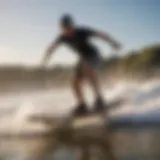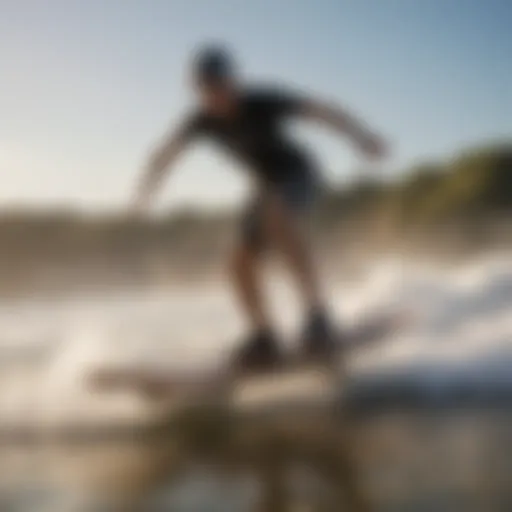Port Canaveral Marine Forecast for Kitesurfers
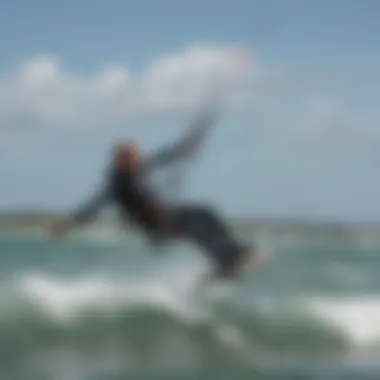

Intro
Port Canaveral is a well-known hub for kitesurfing and kiteboarding. Understanding the local marine forecast is critical for avoiding mishaps and making the most of your time on the water. This guide will explore the essentials of the marine forecast in Port Canaveral, emphasizing wind patterns, tides, and safety protocols. Whether you are a beginner or an advanced rider, knowing the resources at your disposal can greatly enhance your overall experience.
Equipment Reviews
Kites
The right kite can make a significant difference in your kitesurfing experience. Recent models, such as the Duotone Neo and the Cabrinha Switchblade, have brought innovations in features and performance. When choosing a kite, consider its shape. C-shaped kites offer excellent power and speed, making them ideal for experienced riders. On the other hand, delta shapes are more stable and forgiving, catering well to beginners. As for size, it is crucial to match the kite to the expected wind conditions for optimal performance.
Boards
Different types of kiteboarding boards offer unique riding experiences. Twintip boards, such as the Slingshot Misfit, are versatile and good for all-around use. For riders looking to perform tricks, directional boards, like the Naish Box Kite, provide better control in wave riding. Each board type has its own design and construction materials which affect durability and performance. Consider your riding style when choosing a board to ensure it aligns with your skill level and the type of kitesurfing you want to pursue.
Accessories
No kitesurfing setup is complete without essential accessories. Among the most important are harnesses. A comfortable and secure harness distributes the load effectively, reducing fatigue during long sessions. Safety gear like helmets and impact vests is non-negotiable. They provide essential protection against falls and rough water conditions.
- Lines: Ensure your lines are in good condition; frayed lines can lead to serious accidents.
- Pumps: A reliable pump is a must for quickly inflating your kite, ensuring you spend more time on the water.
- Safety Gear: Invest in a good quality safety leash to keep your kite close during emergencies.
Understanding Marine Forecasts
Understanding marine forecasts is essential for anyone looking to engage in kitesurfing and kiteboarding at Port Canaveral. The intricate interplay of wind, tide, and waves creates a unique environment that can affect performance and safety. Correctly interpreting these forecasts can significantly enhance the experience for both novices and seasoned riders.
Definition and Importance
A marine forecast provides detailed information about atmospheric and oceanic conditions. These forecasts focus on factors like wind speed, direction, tides, and wave patterns, which are critical for water sports. For kitesurfers, knowing the expected wind speed and direction can mean the difference between a thrilling ride and a frustrating experience. Furthermore, awareness of tide levels can help riders avoid hazards and manage their launch and landing sites effectively.
Components of a Marine Forecast
Marine forecasts are comprised of several key elements:
- Wind Speed and Direction: This indicates how strong the winds will be and from where they will come. Strong winds may enable faster rides but also pose a higher risk for accidents.
- Tide Levels: Tides can affect water depth in certain areas, influencing launch conditions and safety.
- Wave Height and Frequency: Understanding the expected wave conditions is crucial as higher waves could lead to increased difficulties for riders, impacting their overall experience.
Wind Speed and Direction
Wind speed and direction play a significant role in kitesurfing. Generally measured in knots, knowing the wind speed helps riders select appropriate gear. A wind speed of 15 to 25 knots is generally considered optimal for kitesurfing, offering sufficient lift without being dangerously strong. The direction of the wind is equally important; onshore winds can provide safer conditions, whereas offshore winds may present risks for getting caught further from the shore.
Tide Levels
Tide levels affect the accessibility and conditions of a given location. In Port Canaveral, the timing of high and low tides can greatly impact the water surface, which is crucial for kitesurfing. An important factor to consider is how tide heights influence launch sites and the distance a rider can go without finding themselves in shallow water. High tides may create favorable conditions, whereas low tides could expose rocks and sandbars.
Wave Height and Frequency
Wave height and frequency determine the overall riding experience. Low to moderate wave heights generally present optimal conditions. High wave frequency may interfere with riding stability and control, especially for beginners. Understanding the expected wave dynamics in advance can help kitesurfers prepare adequately and choose suitable times for their activities.
Port Canaveral Overview
Port Canaveral serves a vital role in understanding marine forecasts specifically for kitesurfing and kiteboarding. Its unique geographical features and climatic conditions make it an attractive location for water sports enthusiasts. Factors like wind direction, tide cycles, and wave dynamics contribute significantly to the overall experience and safety of riders.
Geographical Significance
Port Canaveral is positioned along the eastern coast of Florida. This proximity to the Atlantic Ocean allows for a variety of water activities. The port itself is deep and offers sheltered areas, crucial for creating safer and more controlled environments for kitesurfers and kiteboarders. The surrounding beaches and marshlands also influence wind patterns and water conditions, offering a diverse landscape for navigating expected marine complexities.
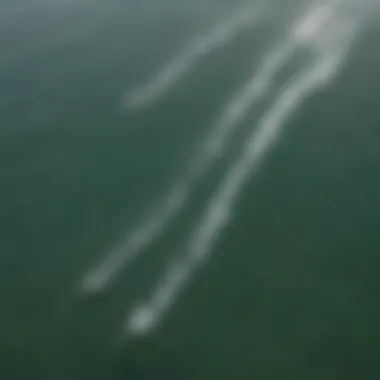

Climatic Conditions
Understanding the climatic conditions in this area is essential. Coastal areas experience different weather patterns than the inland regions, which can profoundly impact kitesurfing experiences.
Seasonal Variations
Seasonal variations in Port Canaveral greatly affect the water sports conditions. For instance, summer months often bring consistent winds, making them favorable for kitesurfing. Most weekends see kitesurfers out on the water, capitalizing on these reliable conditions. However, autumn often sees increased storm activity which can lead to unpredictable weather, presenting challenges for both beginners and experienced athletes. Awareness of the specific seasons can help in planning safe outings, thus enhancing the experience.
Yearly Averages
Yearly averages give deeper insight into what kitesurfers can typically expect throughout the calendar year. On average, Port Canaveral experiences a wind speed ranging from 10 to 20 knots. These numbers can guide kitesurfers to anticipate ideal kitesurfing days. Nonetheless, it is crucial to recognize the alternating years where conditions may vary significantly due to broader climate changes. Knowledge of these patterns particularly assists in selecting the best times to engage in kitesurfing, ensuring an overall positive experience.
Wind Conditions Analysis
Wind conditions are central to the practice of kitesurfing and kiteboarding at Port Canaveral. Understanding how wind influences the sport can make the difference between a pleasant experience and a hazardous one. Wind speed and direction are critical factors that affect the performance of riders and the safety of their activities.
Optimizing kitesurfing requires knowledge of the optimal wind conditions. It is necessary to be aware of the speed at which the wind can support a stable and safe ride. Additionally, riders must consider the influence of weather fronts. Weather systems can quickly alter wind patterns, and recognizing these changes can enhance decision-making for kitesurfers.
Forecasting wind patterns involves analyzing historical data and current meteorological trends. By understanding local wind phenomena, riders can identify patterns that have consistently yielded favorable conditions. Long-term trends can also indicate how wind conditions evolve over the seasons, aiding in strategic planning for kitesurfing trips.
Optimal Wind Speeds for Kitesurfing
In kitesurfing, the wind speed plays a critical role. Generally, the optimal wind speeds range from 12 to 25 knots, depending on the skill level of the rider and the size of the kite. Beginners often prefer lighter winds, around 12 to 15 knots, as they allow for easier control. More experienced riders might thrive in stronger winds, embracing speeds up to 25 knots or higher. Knowledge of these optimal wind speeds empowers kitesurfers to assess daily conditions and make informed decisions.
Influence of Weather Fronts
Weather fronts have marked effects on wind conditions. They can bring sudden changes in wind direction and intensity. For instance, a cold front passing through Port Canaveral might result in gusty, shifting winds that can challenge riders. Understanding how these fronts work can assist kitesurfers in anticipating conditions that may arise, allowing them to adjust their plans accordingly. It is therefore essential to follow weather forecasts and recognize when a front is approaching.
Forecasting Wind Patterns
Forecasting wind patterns provides kitesurfers with insights into what conditions they can expect over time.
Local Wind Phenomena
Local wind phenomena, such as sea breezes and thermal winds, can significantly enhance kitesurfing experiences. For instance, during warmer days, the land heats up faster than the water, creating a sea breeze that typically blows onshore. This wind phenomenon is beneficial because it can provide consistent and predictable wind suitable for kitesurfing. The key characteristic of local wind phenomena is their ability to maintain steady conditions over extended periods, favorable for planning sessions.
Long-Term Trends
Long-term trends focus on seasonal and annual changes in wind patterns at Port Canaveral. By analyzing this data, kitesurfers can identify the best times of year for specific wind conditions. For example, experienced riders may know that certain months yield stronger trade winds while others are calmer. A unique feature of long-term trends is that they provide insights into potential climate variations affecting wind patterns over years. Understanding these patterns can help riders prepare for upcoming seasons, maximizing their enjoyment on the water.
Tide Patterns at Port Canaveral
Understanding tide patterns is crucial for anyone involved in kitesurfing or kiteboarding. Tides affect water levels and can significantly influence conditions for those wishing to ride the waves. At Port Canaveral, tides are dictated by the gravitational pull from the moon and the sun, leading to regular cycles that can be anticipated. Planning kitesurfing sessions around these tide patterns can enhance both the enjoyment and safety of the experience.
Tidal Cycles
Tidal cycles comprise high and low tides that occur roughly every six hours. In Port Canaveral, it is essential to know that these cycles can shift slightly based on the lunar phase and seasonal changes. Typically, two high tides and two low tides occur each day. The height and timing of these tides can vary, making it imperative for kitesurfers to monitor local tide charts.
By checking tidal schedules, enthusiasts can better predict ideal conditions for kitesurfing. For instance, certain times may provide smoother water and less interference from breaking waves, which can be beneficial for beginners.
Effects on Kitesurfing Conditions
Tide Timing and Wind Alignment
Tide timing and wind alignment play integral roles in kitesurfing conditions. When tides rise or fall, they can create currents that either aid or hinder a kitesurfer’s movement. The ideal scenario occurs when wind direction aligns with the outgoing or incoming tide. This alignment helps to maximize the power of the wind, giving kitesurfers more lift and control.
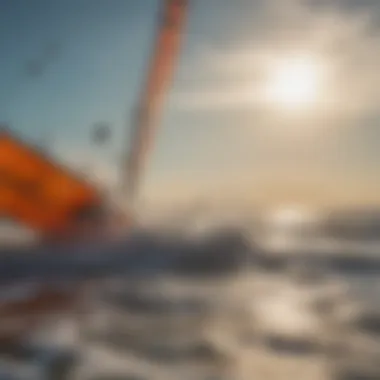

The key characteristic of tide timing is its predictability. Kitesurfers can plan their sessions for times when the tide is just beginning to come in or out. This timing allows for an optimal experience, reducing the risk of encountering choppy waters. However, some may argue that varying wind conditions can lead to challenges even during good tide timings.
Shoreline Changes with Tides
Shoreline changes with tides also have a significant impact on kitesurfing experiences. As tides rise, the shoreline can change dramatically, exposing or submerging areas of interest. Kitesurfers should be aware of these variations while out on the water. The key characteristic of shoreline changes is that they often reveal hidden obstacles or safe zones to land.
This constant change serves as a reminder for kitesurfers to stay alert. Areas that appear deep may suddenly become shallow, which poses a risk to riders. However, understanding these patterns offers advantages, such as knowing which spots may have calmer waters or better waves during specific tidal cycles. Being aware of such dynamics can enrich the overall kitesurfing experience at Port Canaveral.
Key Takeaway: Tides are a fundamental factor that shapes the kitesurfing environment. By comprehensively understanding tidal cycles, timing, and shoreline changes, enthusiasts can better plan their adventures.
Wave Conditions and Their Impact
Understanding wave conditions is essential for kitesurfing and kiteboarding at Port Canaveral. The intersection of wind patterns and water dynamics forms the basis of riding conditions. Knowledge of waves can enhance performance, enjoyment, and safety for both novice and experienced riders.
Understanding Wave Dynamics
Wave dynamics involve the study of how waves are formed, propagated, and dissipated. In Port Canaveral, these dynamics are influenced by several factors:
- Wind: The direction and intensity of local winds greatly affect wave formation. Strong winds can generate larger waves, while gentle breezes may create a calmer surface.
- Geographical Features: The coastal layout and underwater topography can modify wave behavior. Rip currents and sandbars can create unexpected challenges for kitesurfers, affecting how waves break and the conditions in which they ride.
- Tide Influence: Tides cause variations in water levels, which can enhance or reduce wave size. Understanding tide schedules can help predict optimal wave conditions for kitesurfing.
Kitesurfers must stay informed about these elements to ride safely and effectively. Assessing wave patterns helps in determining which areas are best for practice and enjoyment.
Safety Implications of Wave Height
Wave height is a critical factor when considering safety during water sports:
- Moderate to High Waves: Higher waves can be thrilling but pose a significant risk. They can surprise even the most skilled kitesurfers, leading to instability and potential accidents.
- Low Waves: Smaller waves may seem ideal for beginners. However, inconsistency in small wave conditions can lead to poor performance and even injury if a rider loses control.
The right wave height depends on skill level. Beginners should practice in smaller, manageable waves to build confidence and skill.
In addition, paying attention to wave breaks and understanding how they interact with kitesurfing equipment can protect riders. Staying aware of safety measures, such as keeping a safe distance from other surfers and observing local regulations, is paramount.
By making informed decisions based on wave conditions, kitesurfers can optimize their experience while minimizing hazards.
Safety Considerations
In kitesurfing and kiteboarding, safety should always take precedence. Understanding the risks involved can significantly enhance your experience and reduce the likelihood of accidents. Knowledge of wind patterns, wave conditions, and tidal influences is paramount for both novice and experienced riders. Incorporating safety measures allows kitesurfers to enjoy their activity fully while mitigating potential dangers.
Understanding Risks
Wind and Wave Hazards
When kitesurfing, wind plays a critical role. Unexpected wind gusts can result in loss of control. High winds can create waves that are difficult to navigate. It is important for kitesurfers to grasp the potential hazards posed by wind and waves. Understanding these factors can lead to better decision-making on the water.
One major characteristic of wind and wave hazards is their unpredictability. Winds can change direction unexpectedly, leading to challenging conditions. Additionally, the height of waves can vary due to weather changes. These elements are essential considerations for anyone planning to kitesurf in Port Canaveral.
The unique feature of this risk includes the balance between thrill and danger. While many kitesurfers thrive on the adrenaline from high winds and waves, beginners might find these conditions overwhelming. In Port Canaveral, regular monitoring of forecasts ensures that riders are up-to-date with current conditions, which is crucial for a safe experience.
Tide Risk Awareness
Tides influence kitesurfing conditions significantly. A thorough awareness of tidal patterns can help riders choose safe spots for launching and landing. As the tide changes, water levels can shift rapidly. This reflects on the effectiveness of kitesurfing practices. Riders must also take into account the upward and downward flow of water when planning their sessions.
The main characteristic of tide risk awareness is the potential for sudden dangers, like strong currents. These currents can increase during high tide, making it more challenging to control your kite. Being cognizant of the tide schedule is critical for staying safe at Port Canaveral.
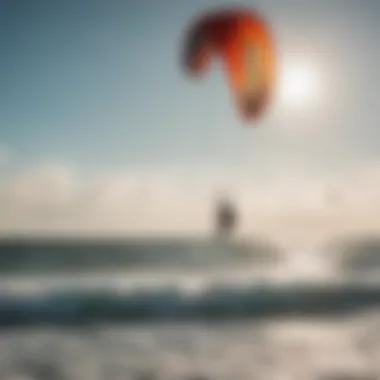

A unique feature of tide risk awareness is its variability based on the lunar cycle. Full moons generate stronger tidal shifts, which can affect the kitesurfing environment. The advantage of being aware of these tidal changes is the ability to select optimal times for kitesurfing, leading to a more enjoyable session.
Best Practices for Safety
To ensure safety while kitesurfing at Port Canaveral, consider implementing the following practices:
- Pre-Session Weather Checks: Always check the marine forecast before heading out. Knowing the wind, wave, and tide conditions is vital.
- Use Proper Gear: Ensure that your kitesurfing equipment is in top condition. This includes the kite, harness, and safety leashes.
- Buddy System: Kitesurf with someone else. Being able to signal for help or share insights can improve safety significantly.
- Know Your Limits: Always be aware of your skills and stay within your comfort zone.
- Understand Emergency Protocols: Familiarize yourself with rescue techniques and know how to contact local authorities if needed.
Maintaining a focus on safety will enrich your kitesurfing experiences at Port Canaveral, allowing you to enjoy the sport while minimizing risks.
Using Technology for Marine Forecasts
In the realm of kitesurfing and kiteboarding, technology serves as a critical ally. The integration of modern forecasting tools enables enthusiasts to harness the full potential of the conditions at Port Canaveral. Accurate marine forecasts aid in planning and decision-making, providing valuable insights into when and where to ride safely. This segment will elucidate the benefits of using technological resources and how they translate into better experiences on the water.
Forecasting Apps and Websites
Various applications and websites specialize in marine weather forecasts. These tools are essential for anyone looking to engage in kitesurfing. Popular options include Windy, iKitesurf, and Sailflow. These platforms provide real-time data on wind speed, direction, and even wave conditions.
- Windy: This app offers detailed weather maps, allowing users to visualize conditions clearly. Its global coverage is a significant advantage.
- iKitesurf: Tailored specifically for kitesurfers, this app includes community insights and localized forecasts.
- Sailflow: Ideal for tracking wind patterns, it provides forecasts tailored to specific beaches and locations.
The ease of access to these tools provides an edge. With just a few clicks, kitesurfers can check the forecast before hitting the water. Staying informed allows riders to maximize their time when conditions align with their skill level and preferences.
Interpreting Data Correctly
While the availability of forecasting tools is impressive, understanding how to interpret the data is equally, if not more, crucial. Users must differentiate between various metrics presented in the forecasts.
Key Elements to Focus On:
- Wind Direction and Speed: Understanding how wind direction affects your kitesurfing can make a significant difference. Ideal conditions often favor side-onshore wind. Wind speed should also match your equipment and skill level.
- Tidal Information: Knowing how tides can affect water conditions helps in planning your session. High tides may bring safer and smoother waters, while low tides could expose hazards.
- Wave Height: Understanding wave dynamics can help in assessing safety and performance. High waves may be exhilarating but pose risks, especially for novice riders.
Interpreting these data points allows kitesurfers to make sound judgments about safety and suitability for their riding style. The right insights can turn an average day into an exceptional experience on the water.
"Using technology effectively can give you an advantage on the water, ensuring you enjoy every ride to the fullest."
Embracing the insights from marine forecasts fosters a safer and more enjoyable environment, paving the way for memorable kitesurfing adventures.
Recommendations for Kitesurfers
Kitesurfing at Port Canaveral can be exhilarating, but making the most of the experience requires careful planning and understanding of specific factors. This section focuses on recommendations that will benefit both beginners and experienced kitesurfers. These suggestions include analyzing daily forecasts and selecting appropriate times to surf, both of which are vital to maximizing enjoyment and ensuring safety.
Analyzing Daily Forecasts
Daily forecasts are the cornerstone of successful kitesurfing. By keeping track of key weather elements, kitesurfers can make informed decisions about their activities. Understanding wind speed and direction, as well as tide patterns, is essential. Most kitesurfers use various apps and online platforms to access this data.
Key considerations when analyzing daily forecasts include:
- Wind Speed and Direction: Look for consistent winds in the range of 15-25 knots for ideal kitesurfing. Be cautious of sudden gusts which may alter the experience.
- Tide Levels: Tides can significantly affect water conditions. Low tides might expose hazards, while high tides can enhance wave activities. Check tide charts regularly.
- Weather Conditions: Pay attention to precipitation and atmospheric pressure. Thunderstorms can develop rapidly, leading to dangerous conditions.
To make the best decisions, kitesurfers should spend time reviewing weather reports in advance. By planning accordingly, individuals can avoid unsuitable conditions, reducing the risk of accidents.
Choosing Suitable Times to Surf
The timing of your kitesurfing session can greatly influence the overall experience. Kitesurfers must consider several factors when deciding the best time to hit the water.
- Wind Patterns: Morning and late afternoon often provide more stable winds. Midday can see gusty conditions, making it challenging, especially for less experienced individuals.
- Tide Timing: Engaging with the tides is crucial. Timing your ride to align with incoming tides can enhance conditions, while also avoiding low tide hazards.
- Daylight Hours: Since kitesurfing occurs outdoors, ensuring there is sufficient light is essential. Daylight not only helps with visibility but also increases safety.
By strategically choosing when to surf, kitesurfers can enjoy an enhanced experience and reduce potential risks.
"Understanding daily forecasts and selecting the right time are essential skills for every successful kitesurfer."
Adopting these recommendations will inform decisions, boost safety, and enhance each outing on the water at Port Canaveral. Engaging properly with marine forecasts and conditions can make the difference between an unforgettable day of kitesurfing and a challenging one.
